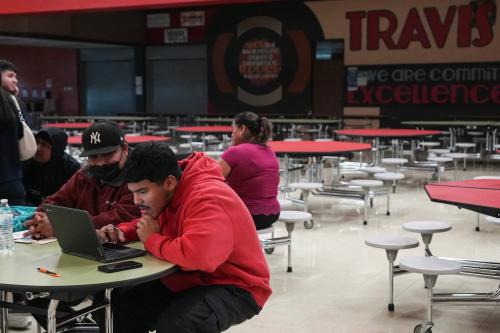For many college students, working while enrolled is necessary to finance their education and cover their basic needs. Many students do it—about 40% of full-time and 74% of part-time college students. College work experiences can also offer non-financial benefits to students. Working while in school can help students identify career interests, build skills and knowledge, and establish networks of peers and supervisors who could help with their post-graduation career trajectories. Moreover, some jobs can build self-efficacy and the satisfaction of contributing positively to local communities.
However, finding a good job that offers multiple benefits is challenging, particularly for low-income or first-generation students who may struggle to navigate the complex college job search processes. When the financial benefits of a job are unclear, students may fall back on stereotypes like “interesting jobs pay badly” and not pursue potentially enriching opportunities. As students balance working while studying, explicitly connecting students with the highest-quality work opportunities that complement, not distract from, their education can meaningfully improve both their work experiences and the returns from earning their degree.
Tutoring can be a win-win job for college students
One high-quality job for college students is tutoring elementary and secondary school students. College students can benefit from these jobs because they can contribute to the community and they can build college students’ skills, not only for teaching but also for other jobs that require skills in motivating others or in the content area of the tutoring. Although many tutoring programs have traditionally relied on college students as volunteers, there has been a push in recent years encouraging universities to use Federal Work Study (FWS) funds and other resources to increase the number of college students supporting school-aged children and youth as tutors. Thus, tutoring can satisfy college students’ financial needs while allowing them to concurrently accumulate non-pecuniary benefits.
At the same time, tutoring benefits K-12 students. The COVID-19 pandemic had large and persistent negative effects on these students’ learning and attendance. In the wake of this educational crisis, tutoring has emerged as one of the most promising and frequently pursued strategies to help support students and schools. While schools have struggled to scale up best practices in high-impact tutoring, when implemented well, tutoring can address long-standing educational inequalities in our nation’s schools. Multiple studies of tutoring leverage college students, and find college students are equally effective at improving student outcomes.
Tutoring is a win-win job for college and K-12 students, but the question remains how best to connect college students who need these jobs with the paid tutoring positions available. In a recent working paper with colleagues, we report on a randomized controlled trial that tested whether highlighting the different benefits of a tutoring job can drive changes in tutor applications and employment. We partnered with Grand Valley State University (GVSU) to recruit paid tutors for a campus initiative started in 2020 to support Michigan K-12 students. Tutoring at GVSU was not only a paid position—it was a highly paid position on campus. Tutors could earn up to $17.70 per hour, the highest rate in the GVSU student hourly wage range and well above the state minimum wage at the time of the study ($10.10).
To test whether information about the benefits of tutoring can affect applications, we designed four emails that each highlighted a different benefit, as summarized in Table 1: the monetary benefit (tutoring is a paid position), the prosocial benefit (tutoring helps local children), the career benefit (tutoring builds career skills and looks good on a resume), and the social benefit (tutoring helps you meet other GVSU students). We tested each of the messages against a standard recruitment email that simply described the tutoring job and served as the control condition. We emailed every student enrolled at GVSU in the term of the study, inviting them to apply for a tutoring position.
Focusing on pay brings college students to tutoring
The emails went out to 15,860 students. Students who received the monetary motivational message were 72% more likely to click through to the application (2.8 percentage points more than the control group rate of 3.9%). As shown in Figure 1, they were also about three times more likely to apply for a tutoring position (2.6% applied relative to the control group application rate of about 0.8%). They were also 196% (almost 3 times) more likely to apply for a tutoring position. We estimated how many overall applications the control and treatment messages would induce if they had been sent to the whole sample: Sending the control group message to all students would have resulted in about 140 applications, whereas sending the message emphasizing that tutoring was a paid position would have resulted in about 410 applications. Although we found no other difference in the rate of applications across groups, the large effects from the virtually costless modification of emails to the monetary focus indicates that colleges should think carefully about how they craft recruitment messages.
Students drawn to tutoring with pay-focused recruitment are just as likely to be successful
More students applied when given messages focused on the pay, but do these messages draw in the good tutors? One way to test whether their applications were as strong as other applications is to look at whether they get hired. The people doing the hiring do not know which message the college students received and are choosing the candidates they think will do the best job.
The applicants who received the pay-focused recruitment emails were at least as likely to be hired as the other candidates. In fact, students receiving these emails were 205% more likely to be hired than students receiving the standard email (a 1.1 percentage point difference). Moreover, these students were 286% more likely to be working as tutors six months later (a 0.6 percentage point increase). We found no evidence that pay-focused recruitment emails reduced the quality of college students who applied to tutor. Securing a well-paying job appears to be top of mind for college students, and emphasizing a good wage does not result in a less dedicated pool of employees.
Highlighting the paid nature of tutoring was the only email approach that had a significant effect on tutoring applications. However, when students applied to become tutors, very few said they were applying because of the pay. About 66% said they wanted to tutor to help the local community, with another 32% saying they wanted to tutor because “I will develop valuable skills” or “I am interested in becoming a teacher.”
The misalignment between their responses to recruiting emails and their self-reported motivations may be students reporting what they think the hiring committee wants to hear. Alternatively, adequate pay might be a personal requirement and they are reporting what motivates their choices among jobs that meet this requirement. In either case, their responsiveness to the emails points to the importance of rigorously testing recruitment strategies. If the college had simply surveyed students asking what would motivate them to become tutors and aligned recruitment strategies to those responses, they would have only sent out emails highlighting the prosocial or career benefits, which had no impact on tutor applications.
Connecting college students to meaningful work opportunities
As many school districts struggle to recruit enough tutors to meet the demand, college students offer a promising and sustainable pool of highly motivated, knowledgeable workers with flexible schedules. Working in college is a valuable part of developing and honing essential career skills, and in the case of tutoring enables students to give back to their local community at a time when K-12 students need dedicated learning support. Creating more paid, enriching college jobs is the first step and must be followed up with clear communication to students about the many financial and professional benefits of these positions.
The Brookings Institution is committed to quality, independence, and impact.
We are supported by a diverse array of funders. In line with our values and policies, each Brookings publication represents the sole views of its author(s).










